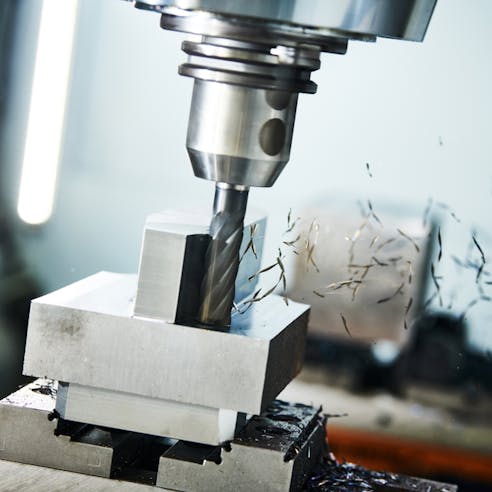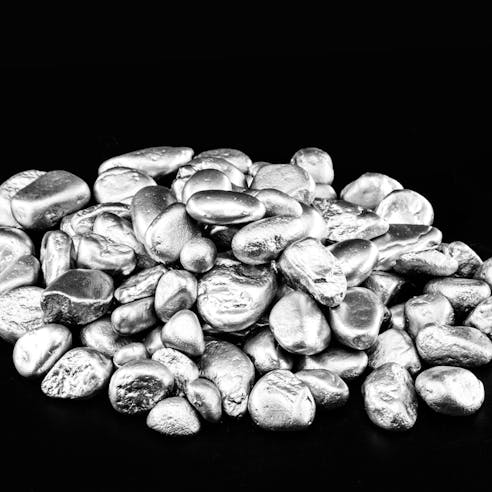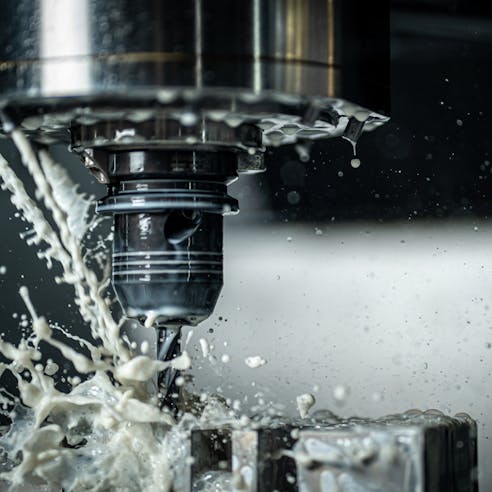Jig Boring Services by Xometry
Xometry offers the highest quality Jig Boring services and can assist in the production of parts with intricate and complex geometries and excellent surface finishes. Subject to availability. Xometry doesn't guarantee that we can provide this service at any given time.
Xometry offers the highest quality jig boring services in order to manufacture precision parts. Xometry is an ISO 9001:2015 and ISO 13485-certified manufacturer. Our jig boring services can match tight tolerances and exact, repeatable positioning. The same machines are also capable of reaming operations. These services can be applied to various metals, including: alloy steel, stainless steel, brass, bronze, aluminum, etc. We most often provide jig boring services to those industries that require highly accurate parts, such as the military, automotive, and medical industries.
What Is Jig Boring?
Jig boring is a highly accurate method of creating precise holes in metal and plastic workpieces. A jig boring machine is extremely precise (the tool can be positioned to micron tolerances) and operations are repeatable (the tool can be placed in the exact same position over and over again). A jig boring machine can therefore produce highly accurate holes with very tight tolerances.
A jig boring machine has a column that holds a spindle head which, in turn, holds the spindle. The spindle moves vertically and allows the boring tool to rotate. This is all mounted over the work table which holds the workpiece and sits on the saddle. The saddle moves horizontally and provides all the necessary longitudinal motion.
Jig Boring Processes
Jig boring machines can accomplish a number of tasks with an accuracy that depends on the tool fitted to them. Listed below are the jig-boring processes:
- Drilling
- Boring
- Milling
- Reaming

Drilling
Drilling is the process of creating a hole in a workpiece. A rotating cutting tool (i.e. a drill bit) scrapes away small amounts of material with each revolution. The tool continues in this manner until the entire hole is complete. The drill bit is pressed against a flat metal surface to begin removing material. Jig boring machines can be used to drill highly accurate holes. However, jig boring machines themselves are not the most efficient ones for ordinary drilling. Often, a better solution is to drill smaller holes with a CNC drilling machine and then transfer the part to a jig boring machine to bore them to the final diameter and tolerance.
Boring
Boring is the process of enlarging an existing hole in a workpiece. Boring is not the same as drilling (the creation of a new hole). Boring tools may progress radially around an existing hole, scraping out material in order to reach the final diameter. A jig boring machine is most often required when the dimensional accuracy of the hole is crucial, including its overall roundness. Jig boring can consistently meet very strict tolerances. Jig boring also ensures the hole is perfectly perpendicular to the workpiece surface.
A variation of boring intended for harder materials is called jig grinding. This process removes less material per revolution, uses different tools, and takes longer to enlarge the hole to its final dimensions.
Milling
Jig boring machines are capable of light milling with small cut depths and low material removal rates. However, they should not be used for heavy milling because they’re not designed to take heavy lateral loads. A CNC milling machine is better suited to general milling operations, but a jig milling machine can provide the finishing touches for precise final tolerances.
Reaming
Reaming is a finishing process for existing holes in workpieces. Reaming produces high-precision holes with very close dimensional tolerances and excellent surface finishes. When fitted with reaming tools, jig-boring machines do very well at this task.
Jig Boring Materials
Jig boring can be performed on a variety of materials. Each material grade needs to be understood in order to select the correct tool, feed rates, and speeds. Jig boring is versatile enough to handle each of the materials below:
- Alloy Steels
- Aluminum
- Brass
- Bronze Alloys
- Carbon Steel
- Copper
- Iron
- Lead
- Stainless Steel

Alloy Steels
Alloy steels come in many different forms. Common alloying elements include nickel, chromium, and titanium. Each alloy is formulated for a specific set of characteristics such as corrosion resistance, tensile strength, and machinability. Jig boring works best on alloys that have high machinability, allowing faster rates and the use of standard tools. The machines also function on alloy steels that are difficult to machine, but they usually demand a slower jig-grinding process.
Alloy steels make their way into thousands of products including drive shafts and gears. Specific industrial applications require high-precision holes made possible by a jig-boring machine.
Aluminum
Aluminum is a relatively soft metal, so it accepts any and all jig-boring processes. High material removal rates can be applied. Aluminum is found in everything from soda cans to highly refined internal combustion engines.
Brass
Brass is one of the easiest metals to machine — particularly if it includes some lead — so it’s easy to bore on a jig boring machine. This versatile metal has good corrosion resistance and gets used for items such as valves, plumbing systems, and specialist fittings.
Bronze Alloys
Bronze alloys are typically very machinable and well suited to boring with a jig boring machine. Alloys such as aluminum bronze can be used for bearings and bushings, and phosphor bronze ends up in springs and bolts.
Carbon Steel
Carbon steel comes in many different grades but their carbon content all falls within a specific range. Typically, these steels are more cost-effective than complex alloys, but they’re still versatile enough for a wide range of applications. Carbon steel can present a challenge with boring; its low tensile strength causes that may necessitate tools with chip breakers.
Copper
Pure copper can be difficult to bore, but the specifics depend on the copper grade. Copper is an excellent electrical conductor and is used for electrical components such as busbars.
Iron
Iron is not used in its pure form in industrial machining applications. Instead, it is alloyed with carbon and silicon as cast iron. Cast iron has a higher carbon content than carbon steel, and is both hard and brittle. This makes it easier to machine and bore because it forms only small chips.
Lead
Lead is a soft metal that deforms easily. This actually makes it quite difficult to bore. The chips and dust are also hazardous and need to be properly handled.
Stainless Steel
Stainless steel refers to a particular family of steel alloys that contain chromium, nickel, and small amounts of other elements such as molybdenum. Different grades of stainless steel, therefore, have different properties and handle differently in machining rigs. However, most stainless steels work harden when they’re drilled or machined. They also generate a lot of heat along the way. In general, it is better to run the tool slowly and apply extra cooling during stainless steel machining operations, but exact needs depend on the specific grade of metal.
Jig Boring Advantages
Jig boring has a number of advantages that make it the ideal precision machining process. These advantages are listed below:
High Accuracy
A jig borer is designed to have extremely high (micron-level) positional accuracy. In addition, its precise motions are repeatable, which means that the tool can be set at the same position over and over again, producing multiple identical holes.
Tight Tolerances
The impressive accuracy and precision of jig boring machines mean they can produce components with very tight tolerances. These tolerances can be as low as 2 µm (0.0001”) in some cases, although they are typically in the range of 5-10 µm (0.0002” - 0.0004”).
Thermal Stability
Temperature variations can cause thermal expansion of the tool or the workpiece material that can, in turn, introduce inaccuracies when machining. To compensate for temperature changes, jig boring machines have symmetrically arranged components along with active cooling systems. Most operators go even further and run their jig boring machines in temperature-controlled environments.
In need of jig boring services?
Jig Boring Disadvantages
Jig boring is not ideal for all applications; the process does have limitations. These disadvantages are listed below:
Slow Process
Jig boring material removal rates are slow; the machines are designed for accuracy rather than speed.
Specialization
Jig borers are intended for specific operations. They’re not designed to handle high lateral loads or any sort of roughing work. Even in drilling or machining operations, the jig boring machine typically isn’t ideal. It would simply take too long and be an inefficient use of the machine.
High Cost
Extreme precision capability is expensive, so every jig boring machine will have a high price tag. The standard to which its components are manufactured, as well as the mechanisms which enable its accuracy, add cost. It is more expensive than a CNC drilling machine or a drill press.
Jig Boring Industries
Jig boring is a versatile machining process that has applications in a wide range of industries such as those listed below:
Aerospace
The aerospace industry requires incredibly precise components with very fine tolerances. Jig boring is, therefore a crucial step in creating sensitive metal parts.
Appliance
A few critical parts in high-quality appliances can benefit from the accuracy of a jig boring machine. Accurate, high-quality parts can improve efficiency and extend the working life of the appliance.
Automotive
The automotive industry uses jig boring, particularly in the manufacture of internal combustion engines. These engines cycle at extremely high speeds, and highly accurate parts with close tolerances make them more efficient.
Industrial
Various industrial sectors require high-precision parts for equipment that rotates at high speed or otherwise undergoes significant forces. Tight tolerances and accurate dimensions are crucial for the efficient performance of that equipment. Bushing holes, for example, often need such precision.
Locomotive
The manufacturing of components for the railway industry often requires jig boring. The cylinder bores of diesel locomotive engine blocks must meet very exact tolerances. Moving parts associated with the wheels must also be bored accurately in order to ensure extended service life.
Marine
Marine equipment is often very large but still requires close tolerances for efficiency. A jig boring machine can meet these precise tolerances even over relatively large-diameter holes. The marine industry is demanding, and so the parts used need to perform with limited wear for many years.
Medical
The medical industry — particularly the manufacture of items such as orthopedic implants — requires the use of jig-boring machines. It is critical to the success of these medical items that their holes for pins, bushes, and pivots are machined accurately.
Military/Mil-Spec
Military-grade equipment needs to be manufactured with precision to ensure no defects will inhibit their reliable operation. Accurate hole boring in components is relevant to weapons, vehicles, and many types of equipment.
Mining
In the mining industry, parts are manufactured to a very high standard to extend service life and reduce the risk of failure. Therefore, a high-precision machine like a jig borer is often used to match tight tolerances in these components.
Mold Making
Molds for casting components typically need to be highly precise, especially if producing items with complex geometries. An extremely accurate mold can also minimize or even eliminate the need for finishing processes after parts are removed from their molds.
Paper and Pulp
The paper and pulp industry uses large, heavy-duty machinery, particularly when chipping logs. These machines employ specialized alloys for improved chemical resistance. Boring these large metal components must often be done with a jig-boring machine.
Power Generation
Jig boring is commonly applied in the manufacture of turbine blades and turbine rotors. These are key components in the power generation industry. Given turbines’ high rotation rates as well as the financial benefit of incremental gains in efficiency, even a slow and expensive process like jig boring is profitable.
Alternatives to Jig Boring
Xometry offers an alternative to jig boring, which in most cases will provide the necessary accuracy:
- CNC Drilling

- CNC Drilling: CNC Drilling achieves essentially the same output as jig boring but with slightly lower precision. CNC drilling is very similar to jig boring, but the drilling machine is not constructed to quite the same tight tolerances. For general-purpose drilling, however, it is more than enough. CNC drilling can be used to drill, bore, or ream, by using different suitable tools.
Why Choose Xometry for Jig Boring Services?

Endless Options
Choose from millions of possible combinations of materials, finishes, tolerances, markings, and certifications for your order.

Easy to Use
Get started with our easy-to-use platform and let our experts take care of managing the project from locating the right manufacturing partner to delivery logistics.

Vetted Network
We are ISO 9001:2015, ISO 13485, and AS9100D certified. Only the top shops that apply to become Suppliers make it through our qualification process.